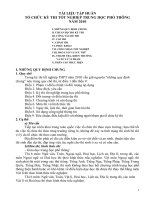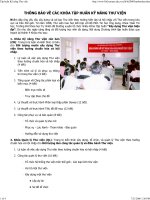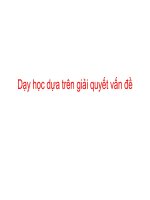tập huấn
Bạn đang xem bản rút gọn của tài liệu. Xem và tải ngay bản đầy đủ của tài liệu tại đây (466.83 KB, 31 trang )
1
E12
1. The role of the
teacher
2
A MOTIVATOR
-
motivate ss
-
get ss involved in
creating activity
-
help ss generate
ideas
A RESOURCE
-
provide information
& language
-
offer advice &
suggestions
A FEEDBACK
PROVIDER
-
give feedback on ss’
writing tasks with
special care
-
respond positively &
encouragingly to the
content of ss’ written
work
2. KINDS OF WRITING IN GRADE
12
3
CONTROLLED
WRITING
-
gap-filling
-
re-ordering
sentences
-
sentence-
building
FREE WRITING
-
letter writing
-
paragraph writing
-
report writing
-
giving instructions
-
describing chart /
book / a sporting
event
4
3. Some problems with free writing
•
A. Many students find it quite difficult
because of
1. having no / lack of ideas
2. limited vocabulary to express opinions
3. disability of using structures ,style or
language in English standards
•
B. Students would probably approach the
task in different ways and produce a wide
variety of different paragraphs
4. Approaching the free-writing
task
5
SELECTING THE
CONTENT
-
analyze the topic
(instruction/ key
terms / the aspect of
the topic)
-
find & select IDEAS
(brainstorming// finding
more ideas)
ORGANIZING
IDEAS
-
classify ideas
-
select relevant
ideas
-
rank ideas
SELECTING THE
LANGUAGE
-
select simple & correct English
vocabulary in terms
-
prepare some common
clauses / sentence connectors /
expressions
-
ensure to have a good grasp of
the essential grammar points
(tenses / passive / parts of
speech / structure)
FACILITATING
WRITING
TASKS
Tasks adaptation and
implementation
1- Making tasks easier:
- Breaking down tasks
- Scaffoldoing
- Lowering requirements
2- Making tasks more challenging/more
interesting
Solutions:
Teachers should help students
progress beyond very controlled
writing to freer writing by guiding
their writing ( GUIDED WRITING)
+ Giving cues.
+ Giving a short text as a model.
+ Doing oral preparation for the writing.
MODELLING
•
1. Reading a model and noticing certain
grammatical features / vocabulary / useful
expressions / text organisation / style…
•
2. Putting different parts of the text onto a
writing frame
•
3. Sequencing a jumbled text
•
4. Comparing and contrasting two forms of
text of the same genre
•
discussing
•
brainstorming
•
observing and
interpreting
photos or
artwork
•
watching video
clips
•
using writing
templates/
frames / cloze
exercises
•
mapping
•
Brain writing
•
Using matrix
Some examples of oral
preparation for the writing
Brainstorming:
–
Getting Ss’ ideas on
paper so they can
give themselves the
widest range of topics
possible
Clustering: mapping out ideas
Environment
destruction
Air pollution
………
………..
……..
Waste
disposal
……
…….
deforestation
Animal
endangered
……
……









